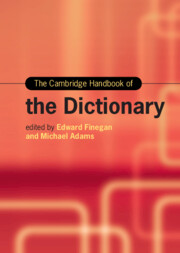Book contents
- The Cambridge Handbook of the Dictionary
- Cambridge Handbooks in Language and Linguistics
- The Cambridge Handbook of the Dictionary
- Copyright page
- Contents
- Figures
- Tables
- Contributors
- Acknowledgments
- Introduction
- Part I Types of Dictionaries
- Part II Dictionaries as Books
- Chapter 9 Dictionary Typography
- Chapter 10 Illustrations in Dictionaries
- Chapter 11 Page and Book Design in Dictionaries
- Chapter 12 Dictionaries in Book History
- Chapter 13 Dictionaries as Material Objects
- Part III Dictionaries and Ideology
- Part IV Dictionaries and Domains of Use
- Part V The Business of Dictionaries
- Part VI The Future of Dictionaries
- References: Dictionaries
- References: Secondary Works
- Index
Chapter 12 - Dictionaries in Book History
from Part II - Dictionaries as Books
Published online by Cambridge University Press: 19 October 2024
- The Cambridge Handbook of the Dictionary
- Cambridge Handbooks in Language and Linguistics
- The Cambridge Handbook of the Dictionary
- Copyright page
- Contents
- Figures
- Tables
- Contributors
- Acknowledgments
- Introduction
- Part I Types of Dictionaries
- Part II Dictionaries as Books
- Chapter 9 Dictionary Typography
- Chapter 10 Illustrations in Dictionaries
- Chapter 11 Page and Book Design in Dictionaries
- Chapter 12 Dictionaries in Book History
- Chapter 13 Dictionaries as Material Objects
- Part III Dictionaries and Ideology
- Part IV Dictionaries and Domains of Use
- Part V The Business of Dictionaries
- Part VI The Future of Dictionaries
- References: Dictionaries
- References: Secondary Works
- Index
Summary
In its broadest sense, book history is concerned with all the media – electronic, printed, handwritten, oral – in which dictionaries have been preserved and circulated. Lexicography began at a particular point in the development of the book, and many topics in the global history of lexicography are book-historical topics. One of the most fundamental of these is the distinction, seen in western and non-western traditions alike, between dictionaries which are made to support ready reference, and dictionaries which are made to support slower, more thorough, study. Another is the distinction between the dictionary text as a single entity, and the body of lexicographical material as a repertoire from which different selections can be made on different occasions. Another is the dependence of the textual structure of the dictionary as we know it on the physical structure of the codex (as opposed to scrolls, clay or wooden tablets, and other media). These topics are of evident continuing relevance to the compilers, publishers, and users of dictionaries in electronic form.
Keywords
- Type
- Chapter
- Information
- The Cambridge Handbook of the Dictionary , pp. 238 - 252Publisher: Cambridge University PressPrint publication year: 2024

